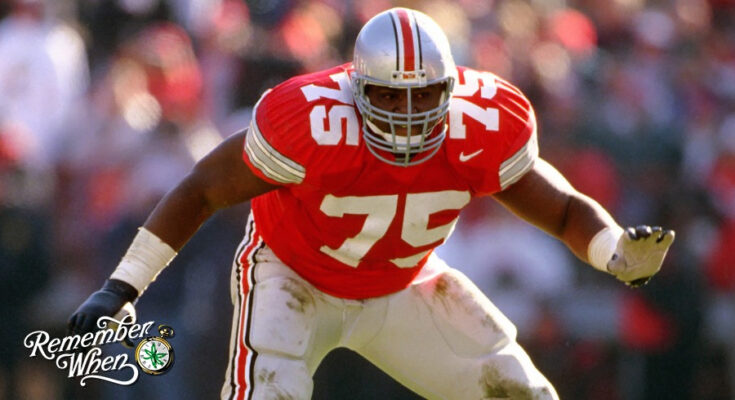Throughout a career filled with dominance and unmatched consistency, no single performance better captured Orlando Pace’s overwhelming presence on the field than his 1995 showdown against Illinois, where he notched an astounding 10 pancake blocks—an effort that still stands as a signature display of his brute strength and technical mastery.
In a career defined by dominance, few moments encapsulate the sheer physicality and brilliance of Orlando Pace more vividly than his 1995 performance against Illinois. Already recognized as a generational talent at offensive tackle, Pace elevated his reputation to mythical status on that autumn day, delivering a display of football power and precision that left teammates, coaches, opponents, and fans in awe. His 10 pancake blocks in that game didn’t just show up in the stat sheet—they told the story of a young man already rewriting the standards of offensive line play in college football.
Pace, a sophomore at the time, had already begun building a reputation as one of the most technically refined and physically overpowering offensive linemen in the country. Standing 6-foot-6 and weighing over 320 pounds, Pace wasn’t just big—he moved with the agility of a tight end and the intelligence of a seasoned veteran. Coaches marveled at his footwork, his balance, his hand placement, and his uncanny ability to read defensive schemes. But against Illinois, all those traits fused into one extraordinary performance that solidified his status as the most dominant force in the college game.
The Illinois defensive line had no answers. Coming into the game, they were confident in their game plan—stunts, slants, blitz packages aimed at confusing a relatively young offensive unit. But from the opening snap, it became clear that they were up against something far beyond their control. Pace wasn’t just blocking defenders—he was launching them. Time and again, he drove players off the line of scrimmage and deposited them flat on their backs. Each time the whistle blew, it seemed another Illini defender was picking himself up off the turf, the victim of yet another pancake block.
Pace recorded 10 pancake blocks in that game—a term commonly used to describe when an offensive lineman flattens a defender to the ground in dominant fashion. But statistics alone don’t capture what those 10 plays represented. They were exclamation points in a performance that redefined what offensive line play could look like. They weren’t merely physical wins. They were demoralizing body blows to the Illinois defense, who over the course of four quarters grew visibly frustrated and worn down. Players who had come into the game full of energy and confidence soon found themselves hesitant off the snap, wary of the punishment they were about to absorb. Few offensive linemen can dictate the emotional tone of a football game. That day, Orlando Pace did exactly that.
And it wasn’t just the pancake blocks themselves that impressed. It was the context in which they occurred. Ohio State’s offense was versatile and high-powered in 1995, and Pace’s ability to dominate one-on-one matchups allowed the Buckeyes to run their full playbook without constraint. He handled speed rushers with patience and poise, countered bull rushes with anchored strength, and frequently took on blitzing linebackers without giving an inch. His pass protection was textbook, often giving the quarterback a clean pocket and ample time to survey the field. But when it came time to run the football, that’s when the brutality of Pace’s dominance was most evident. Running backs often had a clear lane behind No. 75, and it wasn’t uncommon to see defensive ends or outside linebackers taken completely out of the play by the time the back crossed the line of scrimmage.
That performance didn’t just elevate Pace’s personal highlight reel—it shifted the narrative around how offensive linemen were viewed in college football. At a time when skill positions dominated headlines, here was a left tackle becoming a national talking point. Analysts on television were circling his pancake blocks like touchdowns. Commentators were running out of adjectives to describe what they were seeing. Coaches across the country took notice, not just of his power, but of his technique—his ability to marry brute force with football IQ. He wasn’t just better than his peers; he was changing what the position demanded.
Perhaps the most remarkable part of Pace’s game was how effortless he made it look. There was no wasted motion, no unnecessary flash. Every movement was functional, every step a calculated part of a larger plan. He moved with the grace of a much smaller player, bending at the knees rather than the waist, staying balanced, and using his massive frame with precision. He didn’t just block defenders; he eliminated them from the play. And against Illinois, it felt like every drive included a play that left fans gasping and teammates celebrating his dominance.
Coaches and teammates were effusive in their praise after the game. Jim Bollman, Ohio State’s offensive line coach at the time, said he’d never seen anything like it. Teammates spoke with reverence, describing how much confidence they gained just knowing Pace was anchoring the line. Quarterbacks talked about how much easier it was to focus on reads when they didn’t have to worry about the left side collapsing. Running backs knew that if they followed Pace, there was a good chance they’d find daylight. His presence wasn’t just reassuring—it was empowering.
And as word of the performance spread, national attention surged. While offensive linemen rarely made Heisman conversations, Pace started to appear in those discussions—not as a serious contender, perhaps, but as a symbol of just how extraordinary his impact was. He became the face of the Buckeyes’ offensive identity, and his pancake blocks became a point of pride for the entire program. Ohio State even began tracking them officially—a nod to how much he was redefining the metrics of offensive line excellence.
That game also marked a turning point in Pace’s legacy. From then on, every opponent prepared for him with heightened awareness. Defensive coordinators doubled down on film study. Pass rushers spent extra time in the weight room. But few, if any, had success. That Illinois game set a standard, and Pace continued to meet—and often exceed—it in the games that followed. Whether facing future NFL talent or battling in high-stakes conference matchups, he brought the same intensity, the same discipline, the same punishing authority.
By the time his college career concluded, Orlando Pace had become a two-time unanimous All-American, won the Lombardi Award twice, and had etched his name into college football history. But for those who watched his career closely, that 1995 game against Illinois remained a defining moment. It was the day the legend of Orlando Pace became fully realized—a day when dominance wasn’t just a buzzword, but a physical, unforgettable reality witnessed snap after snap.
In hindsight, that performance can be viewed not just as an elite athlete excelling in a single game, but as the symbolic passing of a torch. Offensive line play would never be the same. Future generations of linemen looked up to Pace not only for what he achieved but for how he did it—with humility, consistency, and overwhelming excellence. His 10 pancake blocks against Illinois weren’t just feats of strength. They were statements of intent. Statements that told the football world: this is what greatness looks like.
Even today, years after his college and NFL careers concluded, the story of that Illinois game is still told. It remains a teaching tool in film rooms, a point of reference for coaches, and a measuring stick for rising linemen. When young offensive tackles are told to study the greats, that 1995 tape is often the first they’re shown. And when they see it—when they witness how Pace dismantled an entire defensive front with methodical violence—they begin to understand the standard he set.
Orlando Pace would go on to become the No. 1 overall pick in the 1997 NFL Draft and eventually a Hall of Famer, but for many Ohio State fans and football purists, it’s that one game in 1995 that still resonates the most. It was pure, unfiltered dominance—a performance so overwhelming that even time hasn’t dulled its impact. Ten pancake blocks in a single game isn’t just a stat. It’s a legacy in motion. It’s the moment when Orlando Pace didn’t just play offensive tackle—he perfected it.



